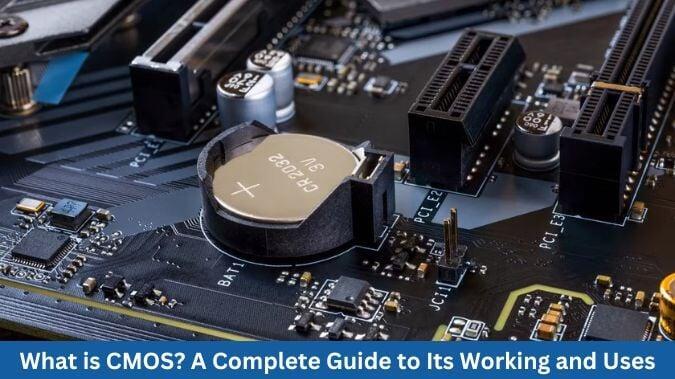What is CMOS?
CMOS is a Complementary Metal Oxide Semiconductor. Here complementary means CMOS uses both N-type and P-type transistors, which work together in a complementary way to perform logic functions. CMOS technology is widely used in design and manufacturing memory chips, digital logic circuits, microprocessors etc.
It is used in various circuits because of its low power consumption, high efficiency, and ability to operate at high speeds. CMOS technology is majorly used in digital electronics for computing devices, smartphones and embedded systems.
Types of Transistors in CMOS
1. PMOS (P-type Metal Oxide Semiconductor)
Working of PMOS
It gets turned on when gate voltage is lower than the source (logic 0 or negative voltage). And gets turned off when gate voltage is higher than the source (logic 1 or positive voltage).
Characteristics of PMOS
Consume minimal static power when used in CMOS technology.
They have good noise immunity which makes it suitable for robust circuit design.
Nowadays, PMOS are used in combination with NMOS transistors.
Applications of PMOS
- Used in pull-up networks to drive high voltage (logic 1).
- For signal switching and amplification, some analog circuits use PMOS transistor.
- PMOS are preferred in power efficient mobile and embedded systems because of their low leakage current.
2. NMOS (N-type Metal Oxide Semiconductor)
This type of semiconductor is built by using n-type semiconductor material and operates when a high voltage (logic 1) is applied to the gate terminal. This transistor is used in microprocessors, memory devices and logic circuits because of their high speed, low resistance and superior electron mobility.
Structure of NMOS Transistor
- Source and drain are made of n-type semiconductor material.
- Substrate is composed of p-type material.
- For preventing direct current flow, a thin insulating layer separates the gate from the substrate.
- A conductive channel forms between the source and drain which allows current to flow, when a positive voltage is applied to the gate relative to the source and when low voltage is applied to the gate, the transistor turns off.
Working of NMOS
- NMOS transistors work when there is electron conduction which makes it faster than PMOS transistors and exhibit better switching speeds and lower resistance.
- The transistor gets turned on when the gate voltage is higher than the source (logic 1 or positive voltage).
- The transistor gets turned off when the gate voltage is lower than the source (logic 0 or ground).
Characteristics of NMOS
- Due to high electron mobility, NMOS transistors switch faster than PMOS.
- Its low ON state resistance improves current flow efficiency.
- NMOS circuits consume more power when not properly optimized.
Application of NMOS
For high speed processing, NMOS transistors are used in modern CPUs and digital circuits.
For enhancing read and write performance, NMOS is used in RAM, ROM and flash memory.
To design power efficient logic circuits, NMOS transistors are paired with PMOS transistors.
They are also used in analog and power electronics circuits for amplification and switching.
Why CMOS Technology Uses Both NMOS and PMOS?
CMOS technology uses both NMOS and PMOS transistors because of the following reasons :
1. Power Efficiency in CMOS
2. Complementary Switching
3. Speed and Performance
4. Noise Immunity and Signal Integrity
CMOS Working Principle
When the Input is HIGH (logic 1):
- The NMOS transistor turns ON and connects the output to ground (logic 0).
- The PMOS transistor turns OFF, preventing current from flowing to the output.
When the Input is LOW (logic 0):
- The PMOS transistor turns ON and connects the output to Vcc (logic 1).
- The NMOS transistor turns OFF, preventing current from flowing to ground.
CMOS Structure
- NMOS transistors are built on p-type substrates in which electrons work as charge carriers.
- PMOS transistors built on n-type in which holes act as charge carriers.
- There is a thin layer of silicon dioxide (SiO2) between the gate and the semiconductor which prevents the direct current flow.
- There is also a metallic gate electrode which is made up of polysilicon or metal to control the flow of current.
- There is separate source and drain for NMOS and PMOS transistors which facilitate current flow when activated.
Application of CMOS
CMOS is used in the fabrication of central processing units, microcontrollers and digital signal processors due to its low power consumption and high speed operation.
CMOS used in FPGAs (Filed Programmable Gate Arrays) and ASICs (Application Specific Integrated Circuits) for customized computing applications.
CMOS is used in memory devices like RAM, ROM, EEPROM which provides fast read and write speeds.
CMOS transistors are used in digital cameras and smartphones to fast processing speed and to improve image quality.
CMOS is also used in medical image devices like X-ray machines, endoscopes and diagnostic imaging systems.
CMOS is also used in wireless and wired communication systems like Wi-Fi and Bluetooth modules, satellite and radar systems.
CMOS is also used in IoT and smart devices for seamless connectivity and automation.
CMOS- Frequently Asked Questions
What is the full form of CMOS?
The full form of CMOS is Complementary Metal Oxide Semiconductor.

